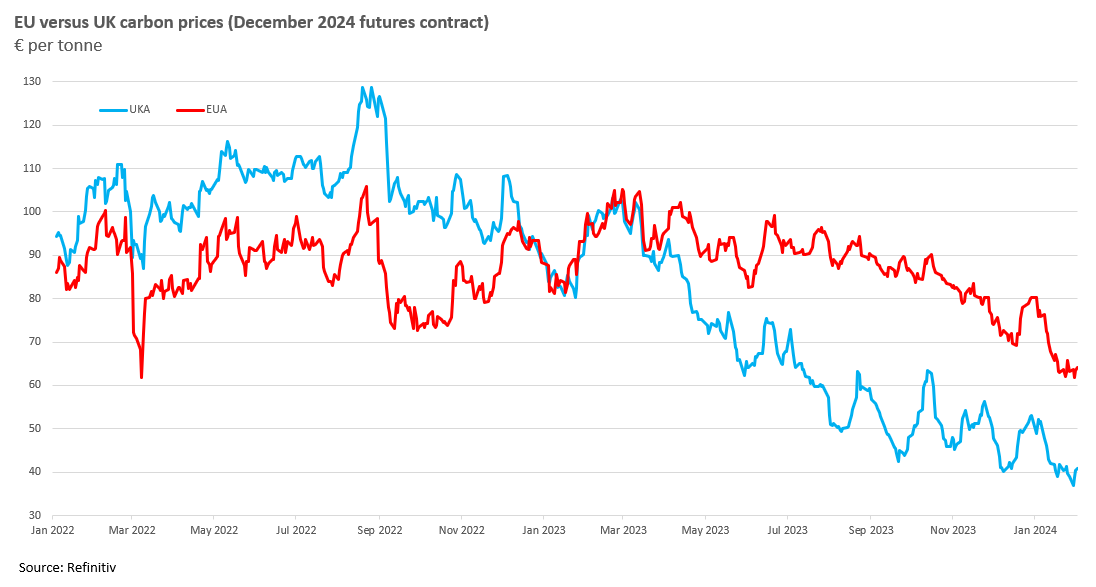Welcome to Carbon Risk — helping investors navigate 'The Currency of Decarbonisation'! If you haven’t already subscribed please click on the link below, or try a 7-day free trial giving you full access.
By subscribing you’ll join more than 3,000 people who already read Carbon Risk. You can also follow my posts on LinkedIn and benefit from my referral program. Thanks for reading!
Estimated reading time ~ 8 mins
The UK carbon price fell to a record low of £31.48 per tonne (€37) last week and the media are starting to notice. The Financial Times led with “UK carbon price falls to record low: Analysts fear inexpensive cost of polluting will deter investment in renewable energy”.
The UK ETS launched on 19th May 2021 and began trading around €54 per tonne, but as the chart below illustrates, it’s fair to say the market has been setting a series of record lows since September. The UK carbon price is affected by the same fundamental factors that have been pressuring the EU carbon price, namely declining natural gas prices, and weak industrial demand, among other factors.
However, the absolute UK carbon price level is not the right comparison to be making. What’s actually important is how it stands up against Europe. Up until the end of 2022 the UK carbon price had been trading at an average ~15% premium to the EU. In late 2022 and into early 2023 that premium closed, and for a while the two markets were joined at the hip (see Recoupling?).
Alas it wasn’t to last.
Ever since mid-March 2023 there has been a clear divergence in their respective paths. While the EUA price has since declined by ~30%, the UKA price has dropped by 55%. Overall, the UK carbon price has plunged by over two-thirds over the past 18 months. Peaking close to €130 per tonne in late August 2022, the UKA price dropped to below €40 per tonne in January 2024.
I have covered the reasons for this disconnect more than once on Carbon Risk. Regular readers will be familiar with my thesis that the carbon price is the ‘Currency of Decarbonisation’. The greater the perception that a particular government might not stick to its self-imposed climate commitments, the larger the discount the market will factor into its carbon price. Indeed, the signs that something was amiss were evident as far back as autumn 2022 (see Commitment issues).
In July 2023 I published Subject to further consultation: The state of play in the UK carbon market. The title a not-too-subtle dig at the ubiquitous references to “subject to further consultation” throughout the long awaited consultation response on UK ETS reform. Apart from an initial rally in the aftermath of its publication, the market rapidly sold off as it became clear that many of the proposals were found lacking. For example, although the emissions cap was to be adjusted down in a manner consistent with net zero, it was achieved in the least ambitious way possible.
Rather than focus on the record low UK carbon price, I’d argue that the more accurate indicator to look at is the UKA discount versus EUA. From that perspective the UK carbon market nadir arguably took place in late September 2023, shortly after Prime Minister Sunak announced that many of the governments net zero policies would be delayed or watered down. The day after Sunak made that speech the UKA percentage discount to the EUA price hit 52%. Over the next 4-5 months the two markets have begun to narrow, although the UK carbon price remains around 35-40% below the EU carbon price.
Could there be scope for the two markets to recouple once more? A number of policy proposals, developments in the UK’s industry and power generation, and forthcoming political events suggest the gap is at least likely to carry on closing (see Invite your friends to Carbon Risk and unlock rewards 🎁).





